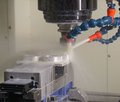Virtual designs into physical objects/Intro
Some of the ways that collaborative designs created on a computer can be physically forged range from getting your hands dirty and crafting it yourself, to sending the design, or at least parts of it, as an electronic file to an increasing number of computer-controlled manufacturing systems such as rapid prototyping or advanced multi-axis CNC machines  that can accurately create parts in 3D in a variety of materials.
that can accurately create parts in 3D in a variety of materials.
What is illustrated in this section is that the world of atoms is starting to catch up with the world of bits in terms of ease of control and duplication. We are entering the age of digital manufacturing. Objects and machines are boiled down to pure information which can be instantly transmitted around the world and recreated physically wherever these 'fabbers' exist. Here are some of the increasing number of methods available to bring virtual designs to life...
